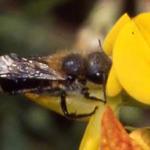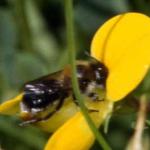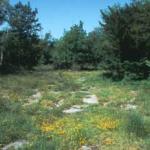Anthophora angustula ZETTERSTEDT 1838; Osmia vankovitzii RADOSZKOWSKI 1887; Osmia hyperborea TKALCŮ 1983
One of three brown and black-haired Osmia bees (O. inermis, O. parietina and O. uncinata) with an arctic-alpine distribution. Saunders (1896) does not distinguish between these three species.
Restricted to the north and west of Britain, this is the most widely distributed of the three species. Modern records are known from western and northern Wales, north-western England and southern and northern Scotland. It is widely distributed in northern Eurasia, from Fennoscandia south to central Spain and east to Greece and eastern Russia.
Listed as a Rare species (RDB3) in Shirt (1987) and by Falk (1991); it has also been listed as a priority species under the UK Biodiversity Action Plan.
Associated with areas of unimproved grassland where its only known pollen source in Britain, common bird's-foot trefoil (Lotus corniculatus), grows. In Cumbria it seems to prefer areas with the shelter of scrub (N Robinson, pers. comm.).
The species is single-brooded. Both sexes fly between May and July.
Females make their nests in a variety of cavities, including dry stone walls and dead wood. The nest is probably made of chewed plant material.
In Britain, common bird's foot trefoil (Lotus corniculatus), bramble (Rubus fruticosus agg.) and bugle (Ajuga reptans). In Germany, Westrich (1989) also lists red clover (Trifolium pratense), horseshoe vetch (Hippocrepis comosa), reflexed stonecrop (Sedum rupestre), germander speedwell (Veronica chamaedrys) and strawberry (Fragaria sp.).
Known to be attacked by the chrysidid, Chrysura hirsuta on the mainland of continental Europe (Stöckhert 1933). The same relationship is likely to occur in Britain. Sapyga quinquepunctata has also been found flying round nest sites of Osmia parietina at Criccieth (NHML collection).
Proofed: February 2012




